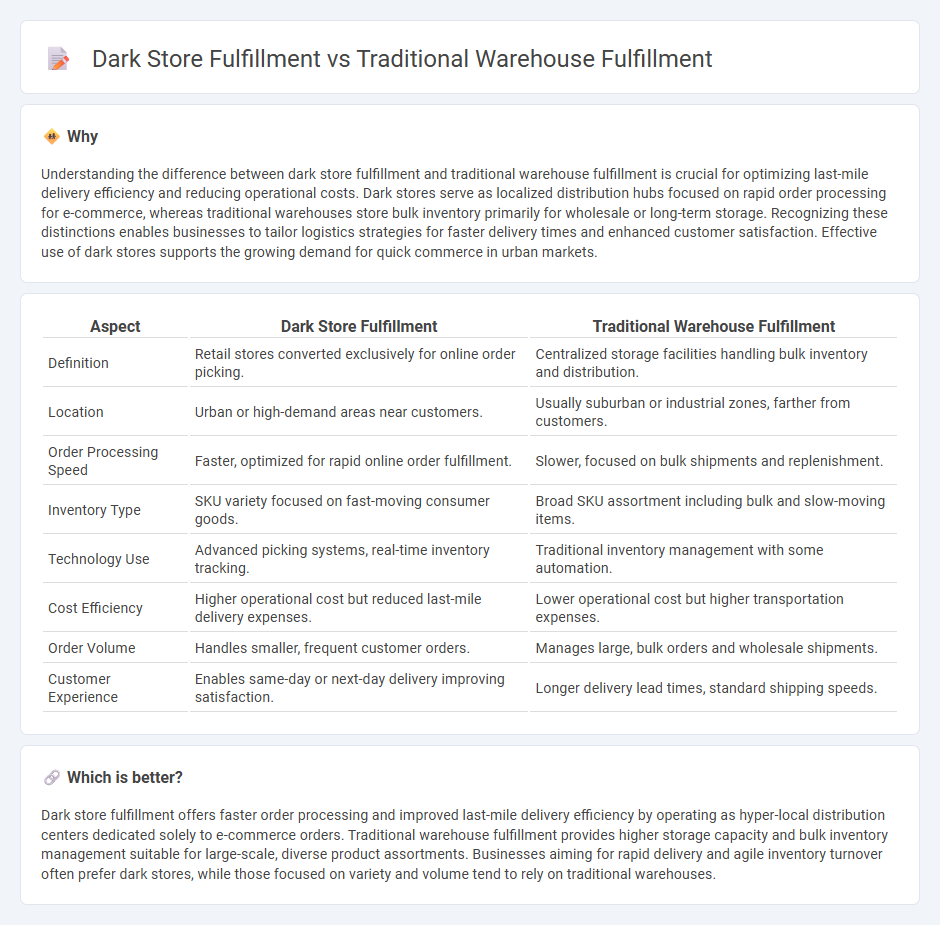
Dark store fulfillment optimizes last-mile delivery by operating as localized distribution centers tailored for rapid e-commerce order processing, contrasting with traditional warehouses focused on bulk storage and slower, less flexible shipment methods. Leveraging real-time inventory management and streamlined picking processes, dark stores significantly reduce delivery times and enhance customer satisfaction. Explore the benefits of dark store fulfillment to transform your supply chain efficiency.
Why it is important
Understanding the difference between dark store fulfillment and traditional warehouse fulfillment is crucial for optimizing last-mile delivery efficiency and reducing operational costs. Dark stores serve as localized distribution hubs focused on rapid order processing for e-commerce, whereas traditional warehouses store bulk inventory primarily for wholesale or long-term storage. Recognizing these distinctions enables businesses to tailor logistics strategies for faster delivery times and enhanced customer satisfaction. Effective use of dark stores supports the growing demand for quick commerce in urban markets.
Comparison Table
| Aspect | Dark Store Fulfillment | Traditional Warehouse Fulfillment |
|---|---|---|
| Definition | Retail stores converted exclusively for online order picking. | Centralized storage facilities handling bulk inventory and distribution. |
| Location | Urban or high-demand areas near customers. | Usually suburban or industrial zones, farther from customers. |
| Order Processing Speed | Faster, optimized for rapid online order fulfillment. | Slower, focused on bulk shipments and replenishment. |
| Inventory Type | SKU variety focused on fast-moving consumer goods. | Broad SKU assortment including bulk and slow-moving items. |
| Technology Use | Advanced picking systems, real-time inventory tracking. | Traditional inventory management with some automation. |
| Cost Efficiency | Higher operational cost but reduced last-mile delivery expenses. | Lower operational cost but higher transportation expenses. |
| Order Volume | Handles smaller, frequent customer orders. | Manages large, bulk orders and wholesale shipments. |
| Customer Experience | Enables same-day or next-day delivery improving satisfaction. | Longer delivery lead times, standard shipping speeds. |
Which is better?
Dark store fulfillment offers faster order processing and improved last-mile delivery efficiency by operating as hyper-local distribution centers dedicated solely to e-commerce orders. Traditional warehouse fulfillment provides higher storage capacity and bulk inventory management suitable for large-scale, diverse product assortments. Businesses aiming for rapid delivery and agile inventory turnover often prefer dark stores, while those focused on variety and volume tend to rely on traditional warehouses.
Connection
Dark store fulfillment and traditional warehouse fulfillment are interconnected through their roles in inventory management and order processing within supply chain logistics. Both systems utilize centralized storage facilities to efficiently pick, pack, and ship products, optimizing last-mile delivery speed and reducing transportation costs. Integration of data analytics and real-time inventory tracking enhances coordination between dark stores and warehouses, improving overall fulfillment accuracy and customer satisfaction.
Key Terms
**Traditional Warehouse Fulfillment:**
Traditional warehouse fulfillment relies on large, centralized facilities where products are stored and orders are processed in bulk, offering economies of scale and efficient inventory management for B2B and retail operations. This method typically involves manual picking, packing, and shipping workflows designed to handle a wide range of SKUs, often supporting longer shipping timeframes compared to faster, localized fulfillment models. Explore more about how traditional warehouses optimize supply chains and adapt to evolving e-commerce demands.
Centralized Inventory
Traditional warehouse fulfillment relies on large centralized inventory hubs designed for bulk storage and order consolidation, optimizing long-term stock management. Dark store fulfillment uses smaller, strategically located centralized inventories tailored for rapid, local order processing and last-mile delivery efficiency. Explore the advantages of centralized inventory systems in both fulfillment models to enhance your distribution strategy.
Bulk Picking
Traditional warehouse fulfillment typically involves diverse inventory storage with mixed order picking, which can slow down bulk picking processes. Dark store fulfillment emphasizes dedicated zones for bulk picking, optimizing layout and technology to increase efficiency and reduce order processing time. Explore detailed strategies and benefits of bulk picking in both fulfillment models to enhance your supply chain performance.
Source and External Links
The difference between a fulfillment center and a warehouse - Radial - Traditional warehouses focus on the long-term storage and holding of inventory, while fulfillment centers handle the full order fulfillment process including receiving, picking, packing, and shipping with advanced technology to ensure fast and accurate order processing.
A-Z Guide to Fulfillment Centers | Function & Benefits - AutoStore - Traditional warehouses act as static storage facilities for goods held long-term, whereas fulfillment centers are dynamic hubs designed for rapid receiving, processing, and shipping of orders, optimizing the supply chain especially for e-commerce businesses.
Fulfillment Center vs. Warehouse: Understanding the Differences - A traditional warehouse stores inventory for long periods, but a fulfillment center performs receiving, inventory management, order picking, packing, shipping, and returns, providing an integrated and efficient solution for order fulfillment.
 dowidth.com
dowidth.com